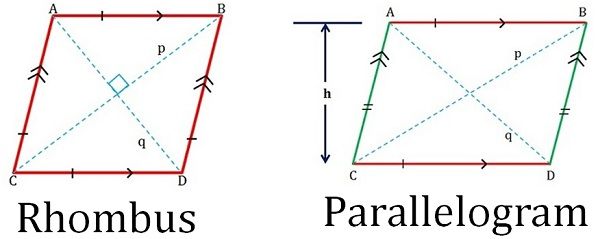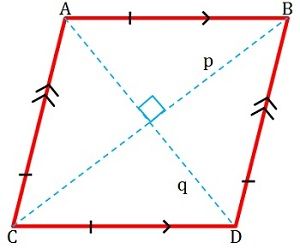 In geometry, there are many types of a quadrilateral i.e. parallelogram, rhombus, square, rectangle, trapezium, and kite, which share common characteristics, due to which people face trouble in understanding these figures. A rhombus can be referred as a slanting square, whose adjacent sides are equal. On the contrary, a parallelogram is a slanting rectangle with two sets of parallel opposite sides.
In geometry, there are many types of a quadrilateral i.e. parallelogram, rhombus, square, rectangle, trapezium, and kite, which share common characteristics, due to which people face trouble in understanding these figures. A rhombus can be referred as a slanting square, whose adjacent sides are equal. On the contrary, a parallelogram is a slanting rectangle with two sets of parallel opposite sides.
The basic difference between rhombus and parallelogram lies in their properties, i.e. all the sides of a rhombus have the same length, whereas parallelogram is a rectilinear figure whose opposite sides are parallel.
Content: Rhombus Vs Parallelogram
Comparison Chart
| Basis for Comparison | Rhombus | Parallelogram |
|---|---|---|
| Meaning | Rhombus refers to a flat shaped, four-sided figure with all sides congruent. | A parallelogram is a four sided flat-shaped figure, whose opposite sides are parallel to each other. |
| Equal sides | All four sides have equal length. | Opposite sides have equal length. |
| Diagonals | The diagonals bisect each other at right angles forming scalene triangle. | The diagonals bisect each other forming two congruent triangle. |
| Area | (pq)/2, where p and q are the diagonals | bh, where b = base and h = height |
| Perimeter | 4 a, where a = side | 2 (a+b), where a = side, b = base |
Definition of Rhombus
A quadrilateral whose length of its sides are congruent is called a rhombus. It is flat shaped and has four sides; wherein the facing sides are parallel to one another (see figure given below).
 The opposite angles of a rhombus are equal i.e. of the same degree. Its diagonals meet each other at 90 degrees (right angle), therefore, perpendicular to each other and forms two equilateral triangles. Its adjacent sides are supplementary, which means that the sum of their measure is equal to 180 degrees. It is also known as an equilateral parallelogram.
The opposite angles of a rhombus are equal i.e. of the same degree. Its diagonals meet each other at 90 degrees (right angle), therefore, perpendicular to each other and forms two equilateral triangles. Its adjacent sides are supplementary, which means that the sum of their measure is equal to 180 degrees. It is also known as an equilateral parallelogram.
Definition of Parallelogram
A parallelogram as its name suggests is a is described as a flat shaped figure, having four sides whose set of opposite sides are parallel and congruent (see figure given below).
 The measure of its facing angles is equal and consecutive angles are supplementary, i.e. the sum of their measure equals to 180 degrees. Its diagonals bisect one another that forms two congruent triangles.
The measure of its facing angles is equal and consecutive angles are supplementary, i.e. the sum of their measure equals to 180 degrees. Its diagonals bisect one another that forms two congruent triangles.
Key Differences Between Rhombus and Parallelogram
The difference between rhombus and parallelogram can be drawn clearly on the following grounds:
- We define rhombus as a flat shaped, four-sided quadrilateral whose length of all sides congruent. A parallelogram is a four-sided flat-shaped figure, whose opposite sides are parallel to each other.
- All the sides of the rhombus are equal in length whereas only the opposite sides of a parallelogram are equal.
- The diagonals of a rhombus bisect each other at right angles forming two scalene triangles. As opposed to a parallelogram whose diagonals bisect each other forming two congruent triangles.
- The mathematical formula for the area of the rhombus is (pq)/2, where p and q are the diagonals. Conversely, the area of the parallelogram can be calculated by multiplying base and height.
- The perimeter of rhombus can be calculated with the help of the following formula – 4 a, where a = side of the rhombus. On the contrary, the perimeter of the parallelogram can be calculated by – adding base and height, and multiplying the sum by 2.
Conclusion
Both parallelogram and rhombus are quadrilateral, whose facing sides are parallel, opposite angles are equal, the sum of the interior angles is 360 degree. A rhombus itself is a special kind of parallelogram. Therefore, it can be said that every rhombus is a parallelogram, but the reverse is not possible.






Mandy says
THANKS A LOT
Aniy says
I reviewed your blog it’s really good. thanks a lot for the information about this blog.I want more information
Michel says
This is a great article, Thank you
Elisabeth says
You know, honestly, this is the best website not only for research but for teachers as well. 10/1o would recommend